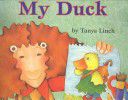
A little girl writes a story and soon it has a life of its own.
- ISBN: 9780439206709
- Author: Linch, Tanya
- Published: 2000 , Scholastic
- Themes: Creative writing, Ducks, Imagination, Storytelling, Teachers
- Descriptors: Americas, Fantasy, North America, Picture Book, Primary (ages 6-9), United States
- No. of pages: 32

Kathleen: This week we engage in a series of books that are written in first person making the characters’ voices strong. Hearing the story from a “primary source” or “first hand” makes these stories jump! My Duck by Tanya Linch (2000) is a quacky story from England about a young girl who has a school assignment to write a story and through many versions rejected by the teacher that her story is not right. The story writer adds a great deal of imagination to her tales including a duck who wears shoes, a little girl who can fly, and a zoo story where all of her characters from other attempts of her story show up.
Jean: The unfortunate, but humorous character in the story is the teacher who consistently tells the storywriter to “start over again” because the stories are not right. The teacher comes across as a very strong authority figure to be obeyed. Kids on a first read-through may not see the humor in this story. The voice of teacher seems very loud – almost screaming. As a reader I sided with the girl immediately and found it humorous that the child would not let go of the voice of her characters. Kids may identify with the child being yelled at and not find that particularly funny until the end when they might just share a sneaky smile with the student author.
Kathleen: I felt anger at teacher for being so narrow-minded and lacking in imagination of all the wonderful drafts of “story” the narrator had to share. Other times I feel despair that there are teachers like this that seem to remove the joy of learning. When I was an elementary student I had an art teacher like her. Our class was assigned an art project, actually it was a “do what I say, and don’t use your imagination project.” I used black construction paper to make reindeer when I was told I was suppose to use brown construction paper. The same sentence came at me, “Start over again.” Interesting how those types of experiences stay in your craw these many years later.
Jean: As adults we laugh at the teacher’s ridiculous thinking and lack of joy. Immediately I said yes to the part that showed roads with trees in the middle of it. My own road as used to have a little island with a tree and a cactus. There are lots of medians in Tucson with lots of trees in them.
Kathleen: Those types of roads on the other side of the country are called Boulevards.
Jean: And really – is the purpose of school nothing more than receiving a gold star?
Kathleen: The humor in this text is that the child pulls one over on the teacher and still receives that coveted gold star. The girl should be the one smiling in the end…and I am smiling with her. At this point the child narrator’s voice becomes very strong because she takes ownership of a story that she creates even if it isn’t the original story that gets turned in “I wrote my story, my duck has a friend and a home, and so does the little girl [in the story], and my teacher gave me a gold star!” And so, everyone was happy.
Jean: Speaking of voice, Children’s literature is a wonderful vehicle for imaginative ways to think about voice. We want to share four other texts that demonstrate a strong sense of voice with humorous books. In The Day the Crayons Quit by Drew Daywalt (2013) each crayon writes a letter to their owner Duncan and has a different point to make. Each point is made with a different voice from anger to embarrassment. Fortunately Duncan finds how to make all of the crayons happy as well as compliments from his teacher for “coloring and an A+ for creativity!”
Kathleen: Another book that exudes voice is Exclamation Mark by Amy Krouse Rosenthal & Tom Lichtenheld (2013). This text gives voice to punctuation through the particular role it plays in communication. He learns how to fit in by finding his inner voice, and that is literally and figuratively. In The Obstinate Pen by Frank W. Dormer (2012) the main character is a pen that voices through writing it what he thinks the character who is holding should really write. This very amusing text will have you laughing out loud because the pen does what it wants to do. I am reminded of Jean Little’s Introduction in Hey World, Here I Am! (1986). “I first met Kate when she walked into a book I was writing…I imagined that I had created her and that I would remain in control. I had a lot to learn about Kate.” The voice of this character was so strong that it just had to burst out. That is the kind of energy I feel when I read any of the books we have looked at here.
Kathleen: So, another connection we see in all of these books is mischief. Next week we will discuss our last book who’s main character is Mischievousness in a very humorous text. Until then….